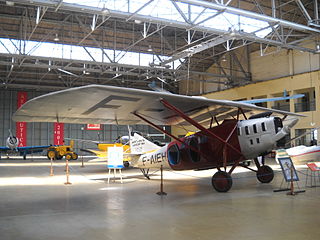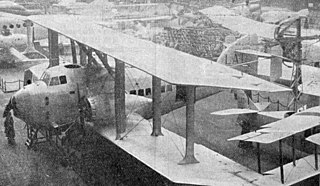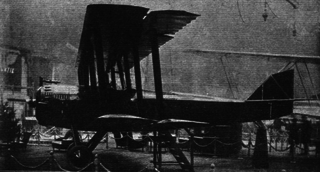
The Latécoère 28 was a successful French long-haul mail plane and passenger airliner of the 1930s. It was the main-stay of Air France's predecessor, Aéropostale, in its efforts to establish intercontinental air mail services and support French colonialism and French cultural influence between the wars.

The Latécoère 521 was a French six-engined double deck flying boat designed and manufactured by Pierre-Georges Latécoère. At the time of its completion, it held the distinction of being the largest aircraft to be built in France as well as one of the first large passenger aircraft capable of flying trans-Atlantic routes.

The Farman F.70 was a 1920s French passenger and mail transport aircraft designed and built by the Farman Aviation Works. It was a smaller counterpart to the company's popular F.60 Goliath. The F.70 was an unequal-span two-bay biplane with a wooden fuselage and was powered by a Renault 12Fe piston engine. The pilot was seated in an open cockpit behind the nose-mounted engine. Behind the open cockpit was a cabin for four passengers or freight.

The Latécoère 26 was a French monoplane mail plane designed and built by Latécoère.

The Fokker F.XIV was a cargo plane built in the Netherlands in the late 1920s by Fokker. It was a high-wing cantilever monoplane of conventional trimotor layout. The sole example was tested by KLM but never put into service.
The Latécoère 14 and Latécoère 16 were similar French passenger and postal aircraft of advanced design built in 1923. They differed chiefly in engine power. Only one of each was constructed. The 14's type number was reused for an unrelated parasol wing prototype that was basis of the more successful Latécoère 17.

The Latécoère 15 was a French airliner built in 1925 for use on Latécoère's own airline on routes between France and Morocco. It was a parasol-wing monoplane of conventional design, with twin engines mounted among the wing bracing struts, and small stub wings fitted to the lower fuselage as a mounting point for these struts and for the main undercarriage units. Six passengers could be carried in an enclosed cabin, and the pilot sat in an open cockpit in the nose.

The Latécoère 17 was a French airliner built in 1923 for use on Latécoère's own airline routes between France and Morocco. The prototype was designated the Latécoère 14, reusing the number of an unrelated earlier design that had been rejected. This new aircraft was a parasol wing monoplane of conventional configuration with an enclosed cabin for four passengers and an open cockpit for the pilot. This was Latécoère's first commercially successful design and as production continued, three different engines were fitted.

The Latécoère 21 was a French flying boat built in 1925 for use by Lignes Aériennes Latécoère as an airliner on routes between France and North Africa. It was the first of the Latécoère flying boats, and the first aircraft to deliver mail between Marseilles and Algiers. It was a conventional design for the era, with a monoplane wing mounted parasol-fashion. Warren truss-style struts braced the wing to stub wings that acted as sponsons for stability while on the water. The twin engines were placed in tandem push-pull configuration on the wing. Up to seven passengers could be seated in an enclosed cabin, and two pilots sat side by side in separate open cockpits.

The Latécoère 25 was a French airliner built in 1925 for use on Latécoère's own airline and its subsidiaries. Essentially a refined version of the Latécoère 17 with an enlarged wingspan, it supplanted that type in production and then in service.

The Latécoère 32 was a flying boat built in France in 1928 for use on Aéropostale's mail routes to North Africa.

The Latécoère 500 was a flying boat built in France in 1931 for use on the transatlantic mail route to South America. Designed to a specification by the French aviation ministry, Latécoère also built a passenger-carrying variant, the 501, which actually flew first. The design was a large, parasol-wing monoplane with broad sponsons and a fully enclosed cabin. Three engines were installed on the wing, two tractor-fashion on the leading edge, and one pusher-fashion on the trailing edge.

The Latécoère 4 was a three-engined, 15-passenger biplane built in France in the early 1920s. It proved difficult to fly and was discontinued, though a second machine was completed as the Latécoère 5 bomber.
The Latécoère 5 was a French three-engined biplane bomber prototype of the early 1920s, based on the Latécoère 4 passenger aircraft. It did not fly until 1924 and only one was built.

The Latécoère 23 was a development of the Latécoère 21 flying boat, a twin-engined parasol winged aircraft. Only one was built, flying and crashing in late 1927. The similar Latécoère 32 was its immediate successor.
The Latécoère 340 was a three-engined, parasol winged flying boat designed in 1929 in France for middle-distance, overseas routes. The sole prototype was destroyed early in the testing programme, and no more were built.

The Latécoère 350 was a trimotor development of the Latécoère 28, a successful single-engined French monoplane of around 1930. The three engines were intended to provide the reliability needed for overnight flights, but the 350 came out very overweight. Only one was built.
The Latécoère 440 was a single-engined, high-winged float plane built as a coastal defence aircraft for the French Navy in the early 1930s. Two were produced to contract but did not impress in tests and the Navy chose instead the Latécoère 290.

The Latécoère 3 was a French biplane transport; the 1919 prototype was a two-seater but the unbuilt production version would have carried two or three passengers as well as the pilot.

The four-engined Lioré et Olivier LeO H-27 was one of three French flying boats competing to carry mail over Air France's South Atlantic routes. Flying later than its competitors, it was not selected and only one was built.
















